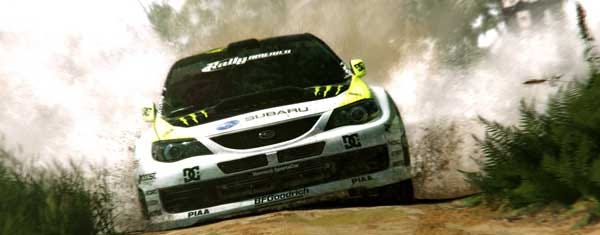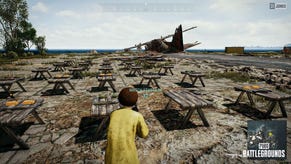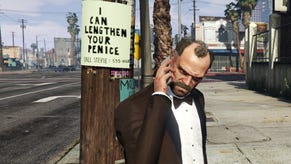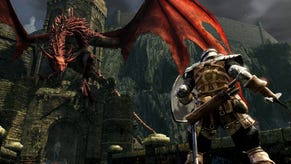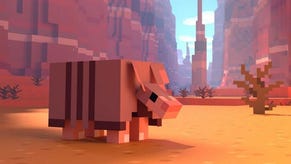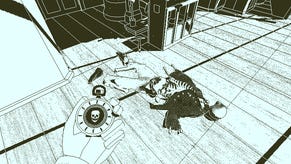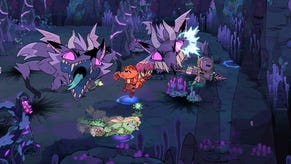DIRT2: Hands On, Devs Speak, Expensive Chair
On a recent visit to Codemasters I had a chance to play DIRT2, and to talk to the lead design team. They explained to me how the game is intended to appeal to a wider, US-dominated audience, and how the core of rally-game realism remains in this rather more excitable racer for the extreme-sports generation. There's also a lovely picture of me sat in one of the most expensive gaming peripherals I have ever been strapped to.
Things kicked off with me feeling rather old. I had no idea that rally had finally penetrated the American entertainment consciousness. Suddenly the snazzy, colourful presentation of the new game began to make sense. This is a racer that intends to chime in with the huge engine of US TV, rather than simply court the classical mud-mastery of international rally. My instincts recoil from that kind of glitz, admittedly, but the Codies team talked the talk, and showed me a ridiculously solid-looking racer too. Off-roading with noise and energy drinks might just work.
Matt Horsman, who is the lead designer on the project, put things into perspective: "DIRT was the basically the most authentic offroad racing experience of a couple of years ago. We added offroad racing classes from the US, official rallycross, and overall more variety so that a wider audience would be interested. With DIRT2 we wanted to increase the fidelity, and then look a bit more at what the Americans do with the X-Games, and the American Rallying Championship. In the US rallying is seen as the new extreme sport, and you've got people like Dave Mirra, the BMX champion, Ken Block, the skateboarder and snowboarder, all those kinds of guys, participating in the new rallying events. It's new to those extreme sports audiences, even though the rest of the world has been rallying for thirty years. They're using the same sort of cars, Subarus and such, but the open class is less restricted on horsepower than World Rally Car."
This begins to explain the angle that DIRT2 is taking: the austere DIRT menus have been replaced with a rock 'n' roll backstage-at-the-event system, with your core menus inside a heavily decorated trailer - your base for international racing operations. Up close it seems far more digestible than I'd expected, even though I loved that original clean-white menu system.
Horsman continued: "As you might expect, the presentation for all this is much more exciting than it has been in Europe. We've traditionally had one guy commentating and a camera on various corners, but in the US they have helicopters tracking cars, cameras on wires above the track, big crowds, and so on. It's very much tied into the "cool" branding of the extreme sports, and DIRT 2 reflects that."
Adam Askew, the producer, chimes in at this point: "The presentation, as you'll see in the menus and such, reflects this more youth-orientated branding, but the focus of the game remains on realism, and on off-road racing being incredibly exciting as gameplay."
Which means the game is, once you get into the driving seat, every bit as down to earth as the original title. "Every location in the game is real, all the vehicles are real, and handle realistically. We've got nine locations: three European, three Asian, three American." And, Askew later reveals, you can elect to use any vehicle on any track. So racing down terrifying gritty tracks tracks in a racing truck is now a possibility. I see glimpses of Battersea power station rallycross events, and a series of Croatian classic mountain rally trails.
The team are proud of the new racing environments they’re creating, although it’s hard to know whether to care about authenticity. What matters is that the tech is so robust, and the feel of the game so positive. This is, in part, down to Codies having a single tech platform which is developing in multiple threads across the entire company - the guys developing tech for Operation Flashpoint are giving it back to the guys developing DIRT2, and back again. One team’s smoke effects will lighten the burden of another team’s realistic dust needs. Not only that but the DIRT2 team has been on the ground, collecting assets, as Askew explained. “We send the artists and designers who are actually working on these levels to those locations, to really capture the “feel” of environment, and you’ll see that they have done that brilliantly.”
For Askew, this attention to "real details" is part of making the game more approachable. He doesn't see realism as necessarily making simulation games difficult to get into. If you make the game look fun and colourful from the front end, people will be compelled to try it out. "It's all about the presentation," he explained. "The packaging amounts to a storyline that pulls you through a game. It's something that simulations do not do, but something we're getting increasingly good at. We're the missing link between people who just want to have a blast in a racing game and the people who want to take games a bit more seriously. The presentation we're working on is about making a player's progress through the game into an event - the original game had great races, but they weren't really connected together. The front end hi-tech design was great, but it distances players from their experience. Racing games have been too austere: they need to learn from action games. Expectations of games are changing across the board, and racing games need to move with that. Look at the personality and character design that gets put into Tomb Raider or Gears Of War - racing games generally don't have that, you're in one car, and then in another car, with no connecting apart from the name of the driver. You're not connecting with a personality." DIRT2 is addressing that issue, says Askew.
Codies producer also thinks that the game will appeal to players on a more basic, collect 'em up level, and a social level, as they round out their career as a driver. "You'll see events become a part of your life in the game - trinkets on the dashboard, souvenirs in your trailer, and so on. But more than that we want players to see their rivals as more than a list of names. We're looking at this banter system that will allow other cars to communicate with you in the race - and there will be less of them, too, so that players can remember who beat them, or who they beat. We want you to have interaction with these other drivers over contact on the track - building teams becomes important later on."
But I couldn't help thinking, wouldn't rally fans be alienated by all this extreme sports stuff? Horsman says not: "No, because the racing is still so authentic. You can still pick simple or technical co-driving calls, and so on, so experienced rally gamers are still catered for. We're still about realism, with proper weight handling now obvious in the way the cars drive - the cars are handling better than ever before, thanks to our continually developing tech. But remember that this is an off-road racing game. The 2005 Colin McRae was a rally game. It's fair to say that the genre is now moving into larger markets."
And I am moving into another room, where the DIRT2 devs strap me into a $15,000 force-feedback racing chair from D-Box. It's the familiar force-feedback racing wheel and pedals, only this time bolted into a chair that is sat on four pistons which throw you about as you play. The photography here doesn't quite capture my being flung into the air by the impacts from the chair. I did not shame myself entirely.
Anyway, hands on and it was clear that the game was as precise and clean a racing experience as ever. The visuals didn't seem to do much to top what we'd already seen in DIRT2, aside from being astonishingly bright and clear, although I was informed that this was a work in progress for the PC, and that higher end systems would be rather more glossy and GRID-beating at release, not to mention supporting very high res systems. I guess we'll see. (The images here are the currently release "target renders", rather than accurate to release-build visuals.)
The four-wheel drive of the Subaru I was driving was lovingly simulated (as is my horrendous spills into nearby trees) with a remarkable sense of applied power as you throw the car around the corners of the Croatian rally course. For the simulation set the game is as precise as previous incarnations, with the shifting weight of cars as they move around inclines and corners being the focus of Codies' physics attention in this new game. It seemed pretty awesome to me, except when I pushed it so far that I flipped the car entirely. Happily, the chair did not flip over in sympathy, and I survived the experience. Of course at home, like most racers, I played DIRT on a game pad. But even with this wheel-chair monstrosity the same kind of fierce, fresh feel to the track was evident in DIRT2. I enjoyed - and continue to enjoy - the previous game, and I do get the feeling that DIRT2 is going to fill the same whole, only with a lot more fireworks and flash-photography.
Ultimately, I suppose there's no real doubt that this will step out as the king of off-road racers when it is released in September. (Which means it took just a year to develop. Blimey.)
